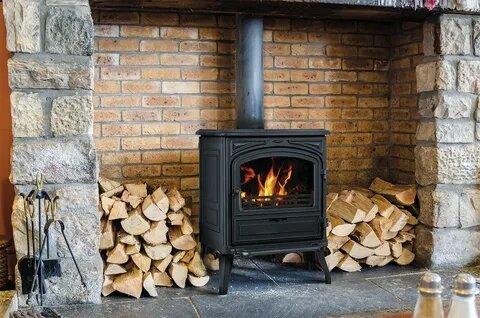How to Install a Wood Burning Stove in an Open-Plan Space
A wood-burning stove can transform an open-plan space into a warm, inviting environment, serving as a focal point that both heats and unifies large areas. Open-plan designs present unique challenges in heat distribution and safety, so a thoughtful approach to stove placement, ventilation, and design elements is essential to create a functional and aesthetically pleasing setup. Whether you’re installing a stove for the first time or upgrading an existing layout, this guide will walk you through the essential steps to install a wood-burning stove effectively in an open-plan space. For reliable and high-quality stoves, Caledonian Stoves provides a comprehensive selection of options to suit any home’s needs.
Step 1: Choosing the Right Stove for Open-Plan Heating
The first step in any successful Wood burning stove installation is selecting a stove that complements the size and heating requirements of your space.
- Stove Size: Larger open-plan spaces may require a high-output stove to maintain comfortable temperatures throughout the area. Generally, stoves rated between 6-12 kW are ideal for larger rooms, but a professional can help you determine the exact power needed based on square footage, ceiling height, and insulation quality.
- Efficiency Rating: Look for a stove with a high efficiency rating, typically 70% or above, to ensure it produces adequate heat without wasting fuel. High-efficiency models from Caledonian Stoves are a great option, as they burn wood more cleanly and produce less smoke.
- Design Considerations: Open-plan spaces benefit from stoves with 360-degree viewing windows or clear fronts, allowing the glow of the fire to be enjoyed from various angles. Modern stoves with sleek designs can add a contemporary touch, while traditional stoves bring a classic charm to the room.
Step 2: Optimal Placement for Heat Distribution
In an open-plan area, strategic placement of the wood-burning stove is crucial for effective heating.
- Central Placement: Placing the stove near the center of the space can help distribute heat more evenly. If the stove is positioned along an exterior wall, heat may remain in one area, leaving other sections cold. Central placement allows the stove’s warmth to radiate outward, reaching all corners of the room.
- Zoning for Efficiency: Use furniture or room dividers to create “zones” within the open plan, such as dining and seating areas. Positioning the stove in or near the main living area allows the warmth to be directed where it’s most needed.
- Air Circulation Considerations: Ceiling fans can help circulate warm air more effectively throughout the space. Set fans to rotate clockwise at a low speed, which pushes warm air from the ceiling down to occupant level.
Step 3: Preparing a Safe Installation Area
With open-plan spaces often connecting multiple rooms, ensuring safety and compliance with local building codes is essential.
- Hearth Pad: A non-combustible hearth pad beneath the stove protects the flooring from heat and stray embers. Hearth pads are typically made from stone, tile, or metal and should extend at least 18 inches beyond the stove door to comply with safety regulations.
- Wall Clearances and Heat Shields: If the stove is positioned near walls or furniture, maintain a safe clearance (generally around 36 inches) or install a heat shield to reduce the required clearance. Heat shields reflect heat back into the room, maximizing warmth while keeping nearby walls safe.
- Floor Protection: Open-plan spaces often include various flooring types, so be sure to protect all flooring near the stove area. Caledonian Stoves offers durable hearth pads and heat shields designed to match a variety of interior styles, ensuring that safety complements your aesthetic.
Step 4: Ventilation and Chimney Installation
Proper ventilation is essential to ensure clean, efficient burning and to prevent smoke buildup within the home.
- Flue and Chimney: A well-insulated, double-wall flue pipe reduces heat loss and minimizes creosote buildup, ensuring a safer and more efficient burn. The chimney should extend at least three feet above the highest point of the roof, creating a strong draft that improves combustion.
- External Air Supply: Open-plan spaces, especially modern builds, are often airtight, which can affect stove performance. An outside air kit provides the stove with fresh air directly from the outside, maintaining proper airflow without disrupting indoor temperatures.
- Draft and Air Circulation: Ensure that the air vents and dampers on the stove are functioning correctly. Control the burn rate by adjusting the air supply, allowing for a slower, more sustained burn that keeps the space warm longer.
Step 5: Insulation and Heat Retention
Open-plan spaces require thoughtful insulation techniques to prevent heat loss and maintain efficiency.
- Insulate Ceilings and Walls: In open-plan layouts with high ceilings, heat can easily escape. Proper insulation for walls and ceilings reduces the amount of energy needed to keep the area warm. For rooms with particularly high ceilings, installing a fan or radiant heat panels may help retain heat at occupant level.
- Sealing Gaps: Check for any gaps around windows, doors, and walls, as these can lead to significant heat loss. Adding weather stripping or insulating curtains can help retain warmth and reduce drafts.
Step 6: Maximizing Heat Distribution
Since open-plan areas require more extensive heat distribution than smaller, enclosed spaces, there are several techniques to maximize the reach of your stove’s heat.
- Convection Fans: Stove-top convection fans don’t require electricity and help push warm air into the room, enhancing heat distribution. This is particularly useful in larger spaces where air circulation may be limited.
- Floor and Wall-Mounted Fans: Use fans to circulate warm air throughout the space. Placing fans near entryways or hallways can help distribute heat to adjacent areas.
- Radiant Heat Reflectors: Place radiant heat reflectors behind the stove to direct warmth back into the room rather than letting it escape through the walls.
Step 7: Choosing the Right Fuel for Efficient Burning
The type of wood you burn impacts both the efficiency and cleanliness of the stove.
- Seasoned Hardwood: Opt for hardwoods like oak, maple, or cherry, as they burn longer and hotter than softwoods. Properly seasoned wood (dried for at least 6-12 months) produces less smoke and creosote buildup, improving safety and efficiency.
- Avoiding Wet or Green Wood: Wet wood contains moisture that lowers burn temperature and increases creosote buildup. Always store wood in a dry place for a more efficient and safe burn.
Step 8: Routine Maintenance for Safety and Efficiency
Regular maintenance keeps your stove functioning efficiently and safely.
- Chimney Cleaning: Creosote, a flammable byproduct, can accumulate in the chimney and pose a fire hazard. Clean the chimney at least once a year to ensure safe, efficient operation.
- Inspecting the Stove: Periodically inspect the gaskets, flue pipe, and air vents. Worn gaskets or dirty air vents can lead to inefficient burning and smoke leakage.
- Ash Removal: Empty the ash pan regularly, but leave a thin layer at the bottom to help insulate the fire and maintain an even burn.
Step 9: Professional Installation and Consultation
A professional installation is crucial for an open-plan wood stove, as it ensures compliance with safety codes and optimizes stove placement and efficiency.
- Building Code Compliance: Building codes vary by location, and a professional installer will ensure your stove meets these requirements, including clearances, venting, and airflow standards.
- Consulting Experts: For guidance on selecting and installing the right stove, Caledonian Stoves provides expert advice and offers a variety of high-quality models that meet different heating needs.
Step 10: Embracing the Aesthetic of the Stove
In an open-plan space, a wood-burning stove can serve as both a practical heat source and a design element.
- Integrate with Décor: Choose a stove style that complements your overall design, from sleek modern lines to rustic cast-iron models. This will make the stove a natural centerpiece that enhances the room’s visual appeal.
- Decorative Firewood Storage: If you plan to store firewood in the open-plan area, use decorative storage racks to add to the room’s aesthetic. Firewood racks made from wrought iron or metal mesh can provide a functional and stylish touch.
Conclusion
Installing a wood-burning stove in an open-plan space offers the dual benefits of efficient heating and stylish ambiance. By carefully choosing the stove’s size and placement, ensuring proper ventilation, and maximizing heat distribution, you can create a warm and inviting space that makes the most of your wood-burning stove. For high-quality stoves and professional installation advice, Caledonian Stoves is an excellent resource, offering a variety of options to ensure your open-plan layout stays warm and comfortable. With the right planning and attention to detail, your wood-burning stove will become an efficient and elegant focal point in your home’s open space.














Post Comment